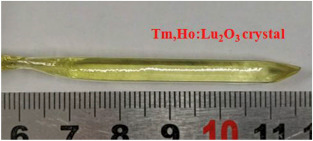For decades, 2 μm lasers based on Tm3+-Ho3+ co-doped host media have attracted much attention in light detection and ranging (LIDAR), free-space optical communication, atmospheric sensors, and the laser microsurgery.
Tm3+-Ho3+ co-doped crystals have been proved to be the best gain-media operating at 2 μm due to the cross-relaxation process and efficient energy transfer. In previous study, a variety of Tm3+ and Ho3+ co-doped hosts have been carried out. Rare-earth cubic sesquioxide crystals are among the most outstanding with high transmittance and low maximum phonon energy. Considering the doping on thermal conductivity, Lu2O3 is the most famous one for its similar mass of the doping ions. For the above reasons, Tm3+ and Ho3+co-doped LuLu2O3 crystal (Tm,Ho:Lu2O3) can be a promising material for 2 μm lasers. However, there remain challenges in the extremely high melting point and great difficulties of crystal preparation.
Recently, a cooperative team from Shanghai Institute of Optics and Fine Mechanics, Chinese Academy of Sciences, and Guangxi University has designed a new preparation process of growing Tm,Ho:Lu2O3 crystal. The structural and optical properties were investigated systematically. The result was published in Optical materials.
For the first time, researchers obtained the high-quality 5 at.% Tm, 0.5 at.% Ho:Lu2O3 crystal through optical floating zone method with the size of ![]() mm3 free from any bubble or crack.
mm3 free from any bubble or crack.
In the experiment, the Lu2O3 host exhibited perfect doping ability because the segregation coefficients of Tm3+-Ho3+ ions were 0.70 and 0.94,respectively, which was carried out by inductively coupled plasma atomic emission spectrometry analysis.
The X-ray diffraction pattern of the Tm,Ho:Lu2O3 crystal showed that the as-grown Tm,Ho:Lu2O3 crystal remained cubic crystal system ![]() and
and ![]() .The absorption cross-section at 796 nm was 4.21×10-21cm2 with the FWHM of 54 nm, which was suitable for the AlGaAs LD. The emission cross-section at 2092 nm was0.20×10-20cm2 with the FWHM of nearly 250 nm and the fluorescence lifetime at 2092 nm was 3.73 ms.
.The absorption cross-section at 796 nm was 4.21×10-21cm2 with the FWHM of 54 nm, which was suitable for the AlGaAs LD. The emission cross-section at 2092 nm was0.20×10-20cm2 with the FWHM of nearly 250 nm and the fluorescence lifetime at 2092 nm was 3.73 ms.
In addition, up-conversion experiments were carried out in order to get detailed information on the excited states dynamics. The energy transfer process between Tm3+:3F4 and Ho3+: 5I7 energy levels was reversible to a quasi-detailed balance, so the lifetime of Tm3+:3F4 manifold also affected the lifetime of Ho3+: 5I7 energy level in the equilibrium state, which could explain the fact that the fluorescence lifetime of the 2 μm emission dropped in Tm3+-Ho3+ co-doped crystals.
The paper introduced a successful preparation process for extremely high melting-point crystals and developed a new gain medium for 2 μm lasers.
This work was supported by National Natural Science Foundation of China, National Key R&D Program of China,Strategic Priority Research Program (B), andMajor Project of Shanghai Science and Technology Research Foundation.

The as-grown Tm,Ho:Lu2O3 crystal.(Image by SIOM)
Article website:
https://doi.org/10.1016/j.optmat.2019.109277
Contact:
Mr. Cao Yong
General Administrative Office
Shanghai Institute of Optics and Fine Mechanics, CAS
Email: caoyong@siom.ac.cn